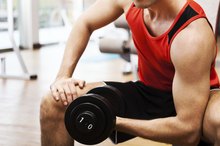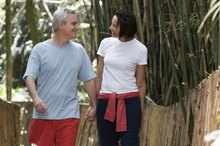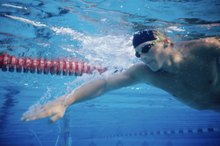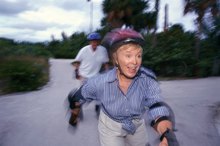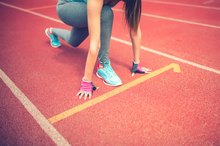Running & Your Bone Density
Bone density is a measurement of the mineral content inside your bones. Individuals with a high bone mineral content tend to have decreased risks for osteoporosis-related fractures. Performing weight-bearing exercises that include running can lead to significant increases in your bone density. However, if you run too much, you can actually decrease your bones’ mineral content and increase your health risks.
Weight-Bearing Exercise Basics
When you perform weight-bearing exercises, your muscles help your body withstand the stress of your activity by pulling on your bones. In turn, this pulling effect promotes increases in your bone density. If you increase the density of your bones early in life, you can substantially reduce your risks for the development of osteoporosis. In addition to running, common weight-bearing activities include stair climbing, walking, rowing, low-impact aerobics and dancing.
- When you perform weight-bearing exercises, your muscles help your body withstand the stress of your activity by pulling on your bones.
Running Benefits
Does Weightlifting Stimulate Bone Growth?
Learn More
The amount and location of the impact caused by weight-bearing exercise have direct effects on your bone density increase, according to the United States Sports Academy. Low-impact options that include walking produce minimal body impact and minimal or no change in bone density. Rowing, on the other hand, produces significant increases in density, but only in your lower spine. Running appears to produce superior improvements in bone density when compared with rowing, as well as other options such as cycling or swimming. It has especially positive benefits for the health of the bones in your legs.
- The amount and location of the impact caused by weight-bearing exercise have direct effects on your bone density increase, according to the United States Sports Academy.
- It has especially positive benefits for the health of the bones in your legs.
Healthy Miles
Moderate amounts of running provide the most beneficial influence on your bone health, the U.S. Sports Academy reports. Runners who get 12 to 19 miles, or 20 to 30 km, of road work per week typically fall into this healthy category. However, runners who regularly exceed this amount of activity risk permanently elevating their blood levels of cortisol, a hormone produced in the adrenal glands that can degrade bone health. In fact, athletes who run roughly 56 miles, or 90 km, per week have shown levels of bone density that are lower than those found in physically inactive individuals.
- Moderate amounts of running provide the most beneficial influence on your bone health, the U.S. Sports Academy reports.
- In fact, athletes who run roughly 56 miles, or 90 km, per week have shown levels of bone density that are lower than those found in physically inactive individuals.
Adjusting Your Routine
Physical, Social, Emotional & Intellectual Benefits of Outdoor Recreation
Learn More
Over time, your body will adjust to the stresses of running or other weight-bearing activities and increases in your bone density will taper off. To avoid this effect, progressively increase your amount of weekly activity until you reach maximum beneficial levels. To gain increased bone density in other areas of your body, combine running with a variety of other weight-bearing exercises. Once you establish an exercise routine, altering it every two to four weeks can help place new beneficial stresses on your body and encourage widespread bone density improvements. If you already have osteoporosis, avoid running and choose lower-impact exercises. Consult your doctor before you begin any exercise program.
- Over time, your body will adjust to the stresses of running or other weight-bearing activities and increases in your bone density will taper off.
Related Articles
References
- University of Maryland Medical Center: Osteoporosis
- Manske SL, Lorincz CR, Zernicke RF. Bone health: part 2, physical activity. Sports Health. 2009;1(4):341-6. doi:10.1177/1941738109338823
- Tucker LA, Strong JE, Lecheminant JD, Bailey BW. Effect of two jumping programs on hip bone mineral density in premenopausal women: a randomized controlled trial. Am J Health Promot. 2015;29(3):158-64. doi:10.4278/ajhp.130430-QUAN-200
- Troy KL, Mancuso ME, Butler TA, Johnson JE. Exercise Early and Often: Effects of Physical Activity and Exercise on Women's Bone Health. Int J Environ Res Public Health. 2018;15(5) doi:10.3390/ijerph15050878
- Klomsten andersen O, Clarsen B, Garthe I, Mørland M, Stensrud T. Bone health in elite Norwegian endurance cyclists and runners: a cross-sectional study. BMJ Open Sport Exerc Med. 2018;4(1):e000449. doi:10.1136/bmjsem-2018-000449
- Cleveland Clinic. The Best Workouts for Osteoporosis.
- Calcium and Vitamin D Supplementation in Osteoporosis.
- Rector, R.; Rogers, R.; Ruebel, M. et al. Participation in road cycling versus running is associated with lower bone mineral density in men. Metabolism. 2008;57(2):226-32. doi:10.1016/j.metabol.2007.09.005.
- Tucker, L.; Fosson, E.; Bailey, B. et al. Is the Dose-Response Relationship Between Body Mass and Hip Bone Mineral Density in Women Influenced by Diet, Physical Activity, or Menopause? Am J Health Promot. 2014;28(5):325-7. doi:10.4278/ajhp.120921-ARB-460.
- Tucker, L.; Strong, J.; LeCheminant, J. et al. Effect of two jumping programs on hip bone mineral density in premenopausal women: a randomized controlled trial. Am J Health Promot. 2015;29(3):158-64. doi:10.4278/ajhp.130430-QUAN-200.
Writer Bio
M. Gideon Hoyle is a writer living outside of Houston. Previously, he produced brochures and a wide variety of other materials for a nonprofit educational foundation. He now specializes in topics related to health, exercise and nutrition, publishing for various websites.
